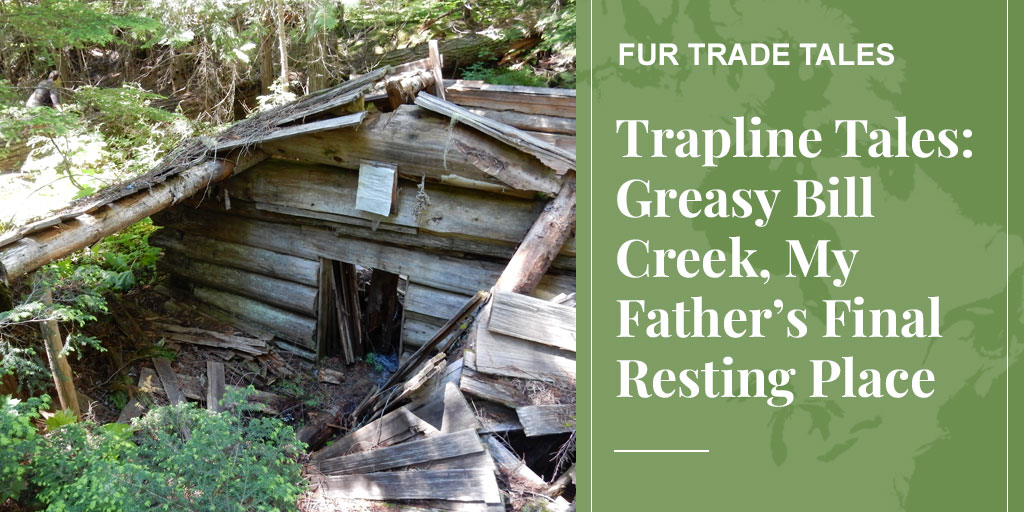
Fur Trade Tales feature real-life stories from real people of the fur trade. This is our third Trapline Tales, but look out for Fur Farm Tales, Furrier Tales, and more to come. If you'd like to contribute, please contact [email protected]
I love reminiscing about the wholesome way of life I experienced growing up in British Columbia on my parents’ trapline in the 1960s and ’70s. In this instalment of Trapline Tales, I’ll introduce an old trapper who played an important part in our lives, even though none of us even know who he was: Greasy Bill.
Our trapline was registered in my father’s name only, but rest assured it was every part my mother’s trapline too. Often she was a weekend widow throughout the winter months, but after I left home, both my parents spent many a day on the trapline, and great times they were.
SEE ALSO: Trail-building in the high country. By Calvin Kania for TruthAboutFur.
So one November, Ma and Pa (as they called each other) headed for a trapper’s cabin located at the confluence of Grizzly Creek and Greasy Bill Creek to get ready for the season that was upon them. The cabins on Dad’s line were built in the 1940s by old-time trappers, this one by a trapper called Greasy Bill. I’m not sure why he got that nickname, but I can only imagine!
SEE ALSO: Ski Doos and marten scent. By Calvin Kania for TruthAboutFur.
The cabins were small, built from large timbers of western red cedars and roofed by hand-split cedar shakes. They were low-rise structures typically fitted with one window, one door, a table or bench and two chairs, a bed, and a wood-burning stove. Flooring was made of wood planks, and a large overhang extended out the front of the porch to keep the firewood dry and to provide a place to hang furs while they were drying. Furs were also dried inside the cabins, but sometimes the ol’ wood stove would be pumping out so much heat the furs could dry too fast.
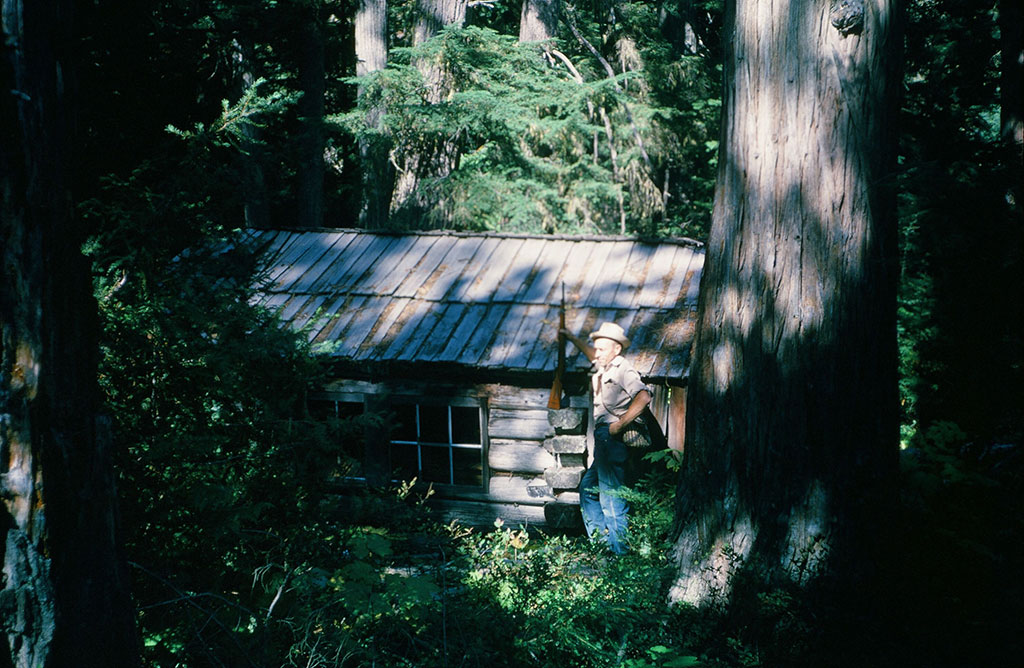
My father liked getting out in November for beaver trapping so he would have marten bait later in the season. For the beaver trapping, he would take the truck back out of Grizzly Creek and head up into the main valley of Koch Creek to a place called Camp Eleven, an old logging camp of the 1940s. Just down the road at Camp 10, which was the main logging camp, is where David Suzuki’s father almost lost his life in an avalanche. My father’s trapline has a lot of colourful history. You could never see any beaver activity from the upper road, but once you got down into the main creek, there was beaver logging everywhere.
At the end of their beaver trapping day, my parents settled into their evening of playing a couple of card games, probably whist or pinochle as that’s what we grew up with, and a shot of rye whiskey was course for the evening. It being November, the rains started to fall, the fog rolled into the narrow valleys and a dampness set in, but with the wood stove burning, Greasy Bill’s cabin was toasty warm.
Wood is the best heat as it’s the most comfortable. My home on the west coast is electric baseboard as back up, but I have wood-burning stove inserts upstairs and downstairs. If it gets too warm, I just open the doors to outside and don’t feel the least bit guilty.
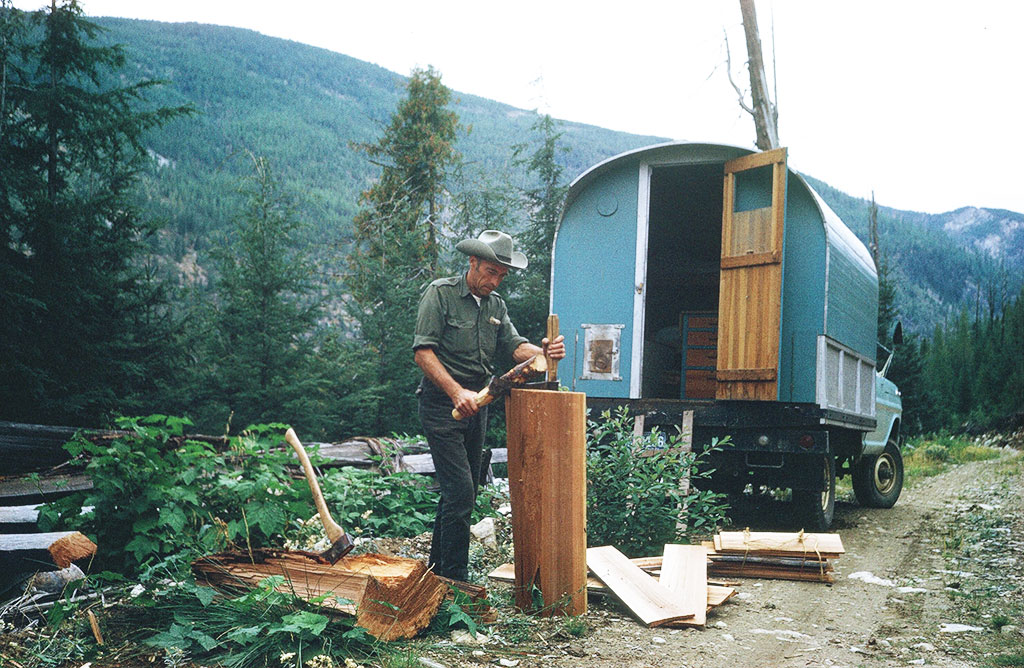
As my parents’ evening of playing cards came to an end, they settled into bed. The coal oil lantern was turned off and left on the kitchen table across the room. It was pitch black. My father could not see his own hand in front of his face. As he was getting comfortable, my mother was already sound asleep and blowing the horn. He chuckled to himself, lying thinking about what and where wolverine and lynx cubbies he was going to build over the next few days. Then he realized that darned wood stove was pumping out the heat again, so much so that he reached over and unlatched the door to the cabin, which slowly opened and a coolness wafted in.
Mystery Visitor
He was lying there thinking of tomorrow when all of a sudden he heard footsteps – four of them. It was right there beside the bed, beside him. It took a few sniffs, walked into the cabin, and sniffed around some more.
My father lay there, thinking out loud in a whisper, “Coal oil lantern on the kitchen table, flashlight on the cupboard bench, rifle standing in the corner on the other side of the room. Hmmm, what now?”
He thought, “The nearest light is the pack of matches in my pants pocket at the end of the bed. Any slight move is going to spook or provoke this animal in perhaps not a good way. What do I do?”
It was either a lynx, wolverine, coyote, bobcat or young black bear. Its footsteps were heavy enough to be any of those. He was anxious to see what it was that so innocently entered the cabin, but if he made a dash across the floor to the flashlight on the bench, there was a good possibility of a mid-room collision. Nah, not a good idea.
He had to be quick, so the matches at the end of the bed were his best bet. He abruptly sat up, grabbed his pants, twisted them upside down, right side up, fumbled for the matches, only to find they were a bit damp and didn’t want to light right away. At the same time the four-legged creature made a quick exit out the cabin door and into the darkness.
While all this commotion was taking place, my mother snorted lightly a couple of times, woke up, and in a groggy voice said, “Huh, what’s going on?” My father replied, “Ahh nothing, I’ll tell you in the morning.”
It being November and the rains upon them, snow had not quite reached the cabin area, so there weren’t any tracks to look for in the morning. The mystery animal will be a mystery forever.
Changing Times
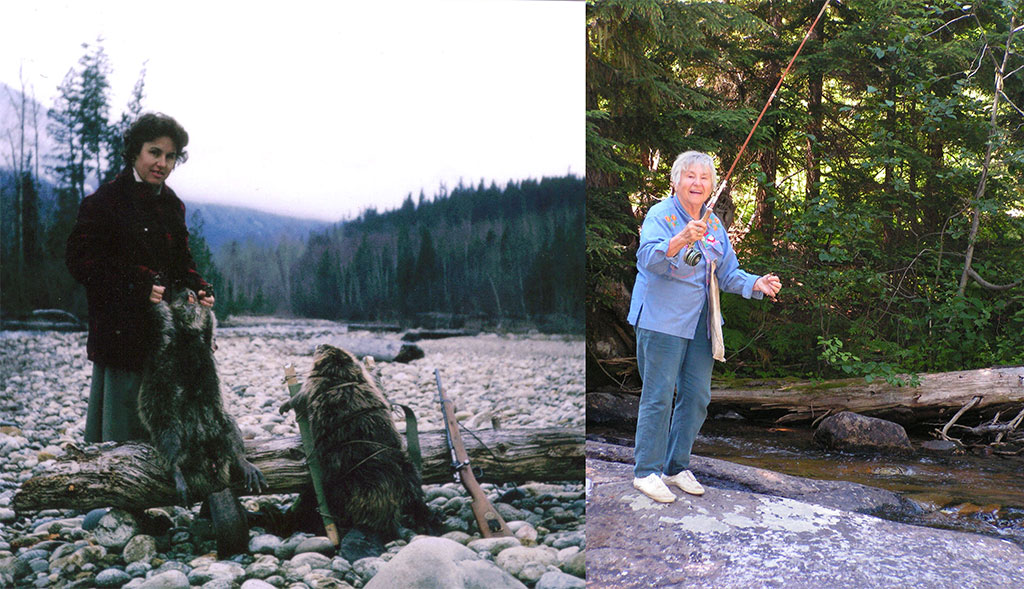
They were great times. Everyone was accepting of the lifestyle, and the Hudson’s Bay Company (HBC) ruled the fur market in Canada from buying trappers’ fur pelts to selling fur garments in their department stores from Victoria to Halifax. Although HBC Point Claire Quebec Auction House did have competition from rivals Dominion Soudak in Winnipeg, Ontario Trappers Fur Auction in North Bay, and Ted Pappas at Western Canadian Fur Auction Sales in Vancouver, they still ran the show. Oh, how times have changed.
Today, I find myself criss-crossing China and other parts of the globe searching out markets for our furs. We have to, as many Canadians no longer understand our trapping heritage. That’s right, our fur trapping heritage.
Canada does have a unique fur-trapping culture which is one of the building blocks of our nation, but it seems that many Canadians are ashamed of it. I will probably take flak for this, but much of the blame lies squarely at the feet of the Canadian fur industry as we allowed this to happen. Companies like Canada Goose should receive the Order of Canada for promoting fur to Canadians. Instead, they’re scapegoated by animal-rights terrorists and an ill-informed public. There is nothing more natural than fur.
SEE ALSO: 5 reasons why PETA won’t make me ditch my Canada Goose. By Alan Herscovici, TruthAboutFur.
Canada is the leading nation when it comes to international trapping standards. We are signatories to the Agreement on International Humane Trapping Standards (AIHTS). I sat on that committee in the early years when Canada was forced to adopt trap standards in order to meet European Union legislation on the importation of wild fur.
Sharing the Land
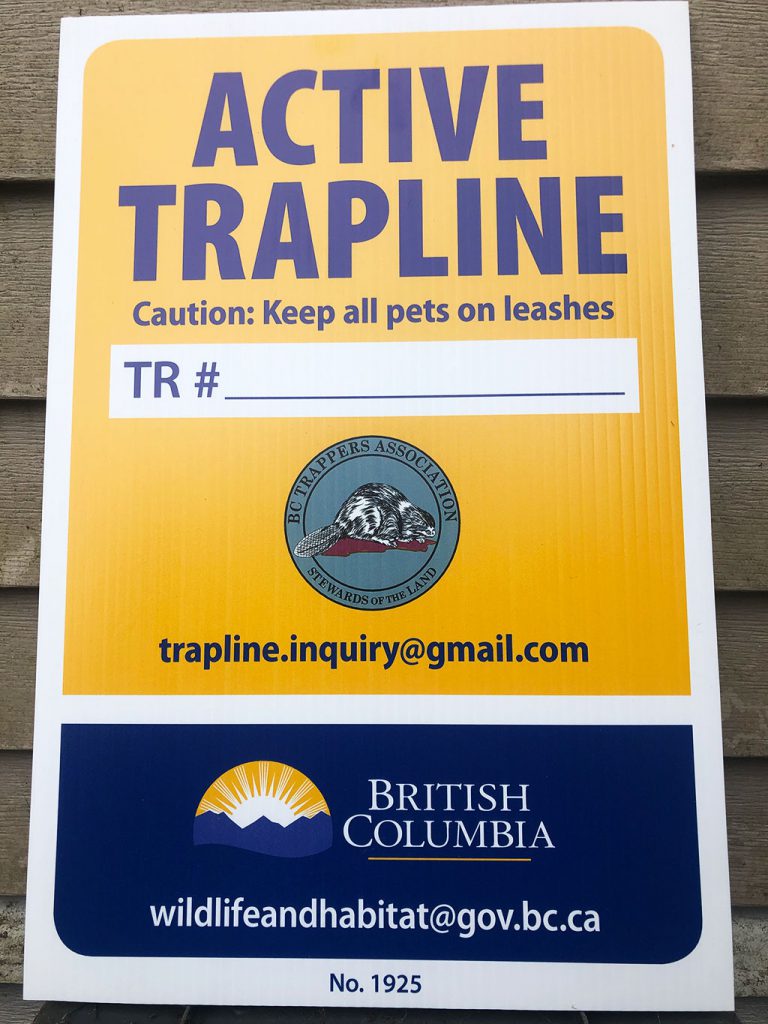
Speaking of the changing world, I want to share a story with all trappers across Canada. Be very aware of your trapping rights. It’s your heritage and don’t let anyone tell you otherwise.
You have to protect yourself against the possibility that, despite following all proper procedures, a domestic animal or pet could unfortunately be captured or harmed. With modern trapping standards this doesn’t happen often, but it can happen. I cannot reiterate enough the importance of having liability insurance on your trapline to cover any eventuality.
Be very aware of your trapping rights. It’s your heritage and don’t let anyone tell you otherwise.
This past winter we found ourselves in a difficult situation. My assistant on the trapline accidentally caught a pet dog in a bobcat set. He was cleared of any wrongdoing by the Provincial Conservation Officer Services; he had followed the law and proper procedures to the letter. My trapline is on Crown Land as all Registered Traplines are in British Columbia. It’s also on Sinixt First Nation Traditional Territory for which I sought permission to be on and was granted permission. However, after a few months we were served with a civil lawsuit by the pet owners in the Supreme Court of British Columbia in Vancouver.
As more city people move into rural areas, the potential for problems increases and trappers are doing what they can to avoid conflicts. For the 2019/20 season, for example, all Registered Traplines across British Columbia will be posted with “Active Trapline” notifications. The BC Trappers Association is working with the Ministry of Forests, Lands, Natural Resource Operations and Rural Development in rolling out this program.
I would also urge fellow trappers to consider posting a notice in your local paper, advising the public about trapping seasons and reminding them of the importance of keeping dogs on-leash – for the welfare of ground-nesting birds and prevention of harassment to other wildlife, and reminding the public about their own responsibilities in the woods.
Trappers also need to put your local Conservation Officer Services on notice that you expect them to enforce the law under the Wildlife Act and lay charges against anyone interfering with legally set traps. If you are worried about interference, trail cams can help to document unlawful acts.
As for our lawsuit we have reached an agreement with the plaintiffs in which the details are locked up in a confidential contract and cannot be disclosed.
Return to Greasy Bill Creek
My father passed away in November 2015, on his 97th birthday. A few days before he died, I took my mother to visit him at the seniors home, she knelt down beside his bed and asked, “Well Pa, do you have any regrets?” “No Ma, I don’t,” he replied.”We did everything we wanted to do in life and more. Heck, we pretty much outlived all our friends. What about you Ma?” She answered, “No Pa, none.”
The service for my father was two weeks later, family and friends attended from far and wide. Through the whole ordeal and for several months after, I never once saw my mother mourn or grieve. Was it shock? Or was it just because they had been together so many years and it was time to go?
The following summer the family arranged a week-long gathering to celebrate my father’s life. The whole family – children and spouses, grandchildren and great grandchildren, uncles, aunts, cousins, in-laws and out-laws – converged on the family homestead. A celebration it was!
We arranged one of our favourite family outings, heading to Greasy Bill Creek for a fish fry. Kids and adults were fitted with fishing licences, fly rods and flies, and were dispersed in all directions up and down both creeks to catch lunch, with instructions to return by 1 p.m. As we approached Greasy Bill’s old cabin, we found it had seen better days. A large hemlock next to the creek had decided to lay its timber across the roof of the shack, and it had caved. But the door was still upright, and above the doorway a sign read, “Trappers Cabin, please respect it and keep door closed. Ed Kania – Trapper”.
As soon as my mother read that, was the moment she broke down and grieved and mourned. It was then and there that took her back to those marvellous days on the trapline with a man she had married 72 years earlier.
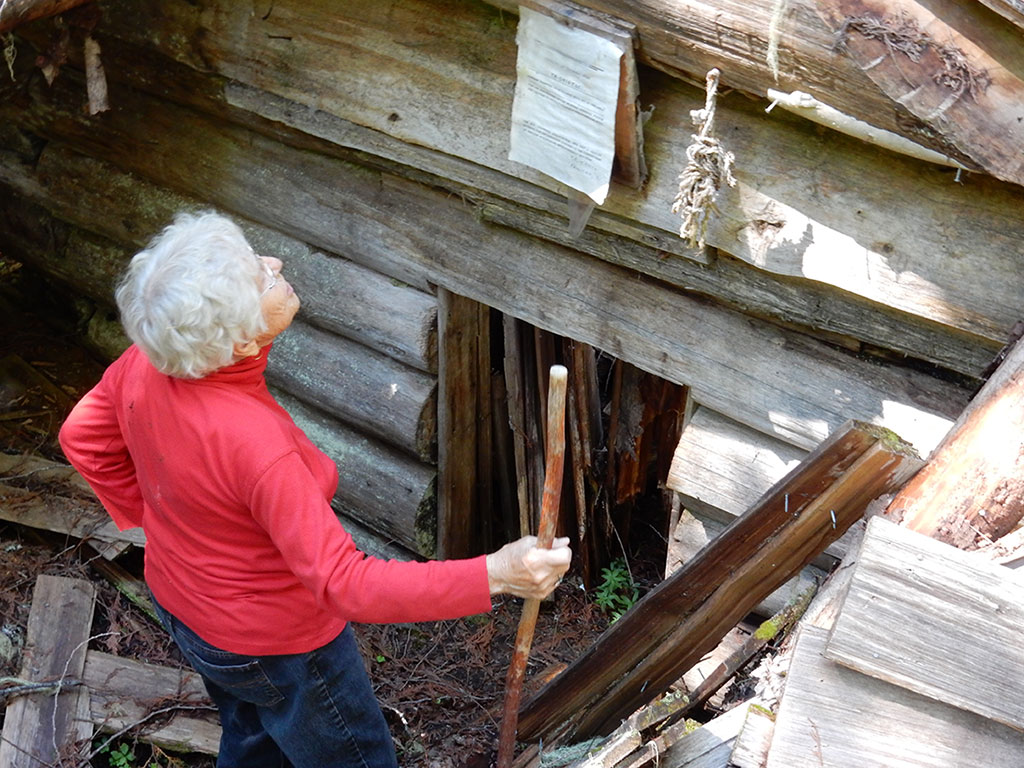











Thanks so much for this! A couple of years ago I caught a glimpse of the cabin driving by but the roads were bad so we didnt go back and then i couldnt remember exactly where i saw it. We’ve spent the last 1 1/2 years trying to find this cabin again and today we found it. So interesting to know your family history and the memories your family had there. Thats incredible. We did snap some pictures today if you’d like updated ones. Not much left of it and its on the verge of collapse.
Richard, my father was an amazing guy. When he invented the Kania Trap 2000, he also had to invent to mold to make the mold.
the kania trap was at the leading edge of humane trapping. one of my fond memories is watching Ed Kania hold onto one end of a piece of spring steel as it wrapped around a revolving shaft until it was right and ready to use .